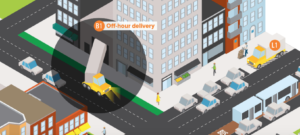Pick any other major city the US, and the situation’s probably the same: a massive surge in deliveries to residential dwellings, one that’s outstripping deliveries to commercial establishments and creating a traffic nightmare. Citylab reports on the changing parcel delivery market from B2B to B2C.
In 2010, the United States Post Office (which has overtaken both FedEx and UPS as the largest parcel-delivery service in the country) delivered 3.1 billion parcels nationwide. Last year, the USPS delivered more than 5.1 billion parcels. The growth in e-commerce is fueling a rise in the number of delivery vehicles on city streets.
While truck traffic currently represents about 7 percent of urban traffic in American cities, it bears a disproportionate congestion cost of $28 billion, or about 17 percent of the total U.S. congestion costs, in wasted hours and gas. Cities, struggling to keep up with the deluge of delivery drivers, are seeing their curb space and streets overtaken by double-parked vehicles, to say nothing of the extra pollution and roadwear produced thanks to a surfeit of Amazon Prime orders.
Christopher Leinberger, chair of the Center for Real Estate and Urban Analysis at George Washington University: “Sending fleets of box trucks through the streets of Manhattan is transplanting a suburban model of e-commerce delivery to a walkable, urban environment”.
Studies revealed the problems that leave delivery trucks idling in the street: no storage space for parcels, no freight elevators for deliveries, and no loading docks to park delivery vehicles.
Many American cities are playing catch-up as they try to understand the new city logistics challenges. That’s due in part to the failures of urban planning and the nature of the trucking business. Citylab: “While matters of public policy like public transit, bike lanes, and walkability fall within the purview of planning boards and municipal departments of transportation, freight has always been a purely private-sector enterprise. That means cities don’t even have reliable data on the number of delivery trucks coursing through their streets”.
Read the full article on Citylab.
Also read this article on the zero emission ambitions of the parcel industry: Web stores are not to blame for the growth in city logistics.

